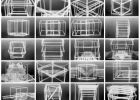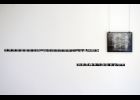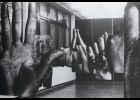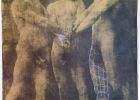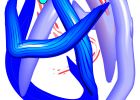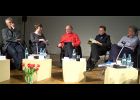El extraño señor llamado Vilém F.
This essay is a reflection from various perspectives on the life and work of Vilém Flusser. Structured as a series of scenes, it connects biographical and geographical reflections, ranging from his escape from Prague, his residence in Brazil, and his return to the city of his birth, with considerations on the peculiar structure and reception of his work, marked by its thematic and disciplinary heterogeneity. Through these scenes, the figure of a nomadic thinker, “groundless” (bodenlos) emerges, one who evades closed systems, inherited traditions of thought, and stable foundations. His life and work are permeated by displacement, discomfort, and constant challenge. Each section emphasizes a different aspect: his relationship with art and design, the playful character of his writing, his polyglot practice and its influence on his creative process, and his way of thinking about technology in dialogue with phenomenology, cybernetics, and philosophy. The aim is not to fix Flusser into a single definitive category as writer or philosopher, but to demystify him, placing him as a man of our present, highlighting his condition as a radical contemporary capable of reading our time as a Heraclitean flow, turbulent and labyrinthine.
Dans l’univers des images techniques – en VF
Although a growing number of Vilém Flusser’s texts have been made available in France, where he spent the last part of his life, the decisive book Ins Universum der technischen Bilder, from 1985, is still missing. Written two years after Für eine Philosophie der Fotografie, his most influential book -- translated into French in 1996, Ins Universum der technischen Bilder is arguably one of Flusser’s theoretically most ambitious books. It aims to describe the entire history of visualization techniques. Both foreshadowing the development of digitization processes to come and harking back to the earliest moments of civilization, this book will make the full potential of the thought-provoking ideas already available in French more readily understandable than they were at the time of their publication. This French translation by Pierre Rusch will facilitate a new understanding of this crucial phase in Flusser’s oeuvre, where the insights into the automated character of the photographic images are taken to the level of a phenomenology of technical gestures, with “abstracting” and “concretizing” as their key operations.
Expanding Photography – Flusser and Polish Intermedia Photography
The essay explores the reasons for the popularity of Vilém Flusser’s ideas on media and history in Polish photography at the end of 20th century. Flusser’s concepts fit perfectly into the thinking about photographic images, which in the 1990s became the leading trend in Central and Eastern Europe. The philosopher’s comments on the “creative gesture” of the photographer, the concept of the universe of technical images, and, above all, the freedom of the artist found a positive response among artists whose art originated in conceptual, performative and “expanded photography” approaches, and created a good foundation for cooperation between artists and academics. Such approaches towards photography gave rise to intermedia photography, which expanded the boundaries of the medium, drawing attention to its formal and socio-cultural context. Furthermore, the paper focuses on photographical case studies by two Polish artists who actively employed Flusser’s vision of media in their art: Stefan Wojnecki and Piotr Wołyński.
Flusser, Media Theory and I. From the Genealogy of Thought
This essay is a case study of a coincidence both in terms of a personal perspective of the author’s encounter with Vilém Flusser’s philosophical and theoretical thought, and with regard to notions of necessity, destiny, and fate. In the present essay, this type of randomness is called ‘primordial accidentalism’. The author discusses his experiences in applying Flusser’s concepts of apparatus, alphanumeric society and technical images, to the creation of concepts referring to digital photography, new media, new media art, cyber-culture and techno-culture. Moreover, the author recalls his experiences with the two Polish editions of Towards a Philosophy of Photography (2004 and 2015), which undoubtedly contributed to the popularization of Flusser’s philosophical concepts among artists, media theorists and philosophers.
"Für eine Phänomenologie des Fernsehens" III: Nam June Paik und eine künstlerische Phänomenologie
When Vilém Flusser arrived at the conference held at the Museum of Modern Art in New York in January 1974 he did not know that an artist was responsible both for the conception and the title of the meeting. Flusser aspired to develop his media theory differently and in front of a completely different philosophical background as McLuhan. Nam June Paik, at that time in his zenith, most likely influenced Flusser philosophically as well as in terms of art examples and much more than Flusser was ready to admit in his short reference to one of Paik’s early non-electronic pre-video films. It is a bit strange that Flusser shied away from the confrontation with art in and with television. It is all the more important to determine the theoretical space that Nam June Paik must have opened to Flusser and others. Against this background it becomes clear that Flusser was able to approach the heritage of phenomenology in a more open und artistic, that is, in a more literary and essayistic way.
Fred Forest / Media, gestures and society. Dialogues between Vilém Flusser and Fred Forest
Mídia, gestos e sociedade. Diálogos entre Vilém Flusser
The present article proposes a dialogue between Vilém Flusser’s media theory, especially focusing upon his books Filosofia da Caixa Preta (1983) and Les Gestes (1999), and the artistic projects developed by the French multimedia artist Fred Forest. Each in his own way acted towards the creation of a critical and reflective spirit about the world seen as a “black box.”
Communication Technologies as Grammars: Medium, Content and Message in Marshall McLuhan's work
This paper aims at exploring some classic concepts in the field of Communication Studies such as medium, content, and message, inspired by Marshall McLuhan’s thought. The paper will also recover a perspective which is still considered useful to the understanding of digital media: the idea that each technology of communication must be recognized as a kind of grammar capable of creating and shaping new modes of communication. Therefore, the dictum ‘the medium is the message’ will be analyzed by re-evaluating the different meanings that the ideas of medium and content assume throughout McLuhan’s work.
Sagrado e profano na escrita. Vilém Flusser e Christoph Türcke
The article compares two readings of the dialectic of the sacred and the profane in relation to the concept of writing. Flusser believed that there is no future for writing because it becomes an obsolete code, increasingly overcome by programming. Türcke, on the other hand, observed that the paradigm shift introduced by new media did not change in any way the basic structures of capitalism, on the contrary, it reinforced and renewed them. While Flusser stated that writing is profane, linear, and therefore tied to the conditions of causality, historicity, authorship and scientific progress, Türcke examined a historical development of writing, which explored the specific functions of the profane and the sacred.
Vilém Flusser e a Terceira Catástrofe do Homem ou as Dores do Espaço, a Fotografia e o Vento
Vilém Flusser’s contribution to modern Media Theory might have found a possible synthesis in his text “Nomadic Reflections” presented in one of the ‘Kornhaus-Seminare’ organized by Harry Pross, on the subject of Euronomadism. Flusser presents a division of the history of humankind into three great catastrophes: humanization, civilization and a third catastrophe, still nameless. This last one that is occurring now will turn humankind back to nomadism. Wind, the desert, granules and emptiness become again decisive categories for the communicative behavior of humankind, already perceivable through photography and technical images. Things and their materiality lose in value, non-things and their immateriality gain in value.
